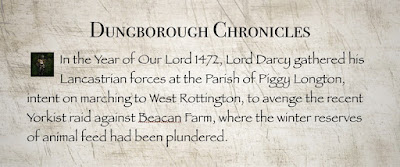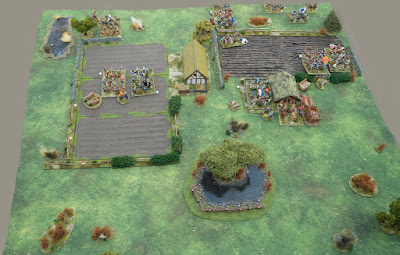The reader may recall that on New Year Day, Yorkist forces under the command of Sir Bartholomew Rolfe, raided Beacan Farm and embarrassed Lord Darcy (Lancastrian), by stealing a goodly proportion of Piggy Longton’s winter feed.
That feed was essential to surviving the winter, so there was no choice other than to get it back, but honour and reputation also demanded that Lord Darcy took steps that would penalise the Yorkists and discourage them from making further raids in the future.
This carried a real risk of military escalation between Lords Darcy and Trebian and by implication, between the Yorkist and Lancastrian factions at a regional or even national level - some care was needed!
To read about the action as recorded in the Chronicles, please use the ‘read more’ tab.
The Yorkists had in total stolen 21 bushels of feed from the barns at Beacan Farm (see the Resource Section below for the post covering this). In his Council of War with his advisors, Darcy had to be calmed by cooler heads, such was his rage at the embarrassment that he had suffered at the hands of Lord Trebian at Beacan Farm.
The devils shall payeth a price f'r their deeds
The discussion, or compromise at least, was that the Lancastrian counter-raid would retake the 21 bushels, no more, no less. That would be the equaliser, but punishment at the insistence of Lord Darcy would come in the form of burning this Yorkist barn to the ground, with whatever feed remained in it.
The Council agreed that by not attacking other barns, this was a balanced approach of hurting Lord Trebian, without wreaking the devastation that would see both animals and population at West Rottington without food and the military consequences that would likely fall from that.
On February 15th, assembling his force at Piggy Longton, Darcy addressed his commanders. They would advance to the outskirts of West Rottington and attack Duncoomb Farm, just beyond Dubmere (the Black Pond).
Sir Percival Tredington would lead the Vanguard, their task was to seize food and burn the barn (the mechanics for doing this are the same as those described in the previous post covering the raid at Beacan Farm). Darcy would command the Mainward and Sir Giles Staverton, the Rearguard and their task was to protect the van and engage the enemy as necessary.
Once the 21 bushels of feed had been re-captured and the barn set alight, the Lancastrian forces would withdraw.
Darcy departed before dawn. Trebian had been expecting a counter-strike much earlier, back in January and had started to believe that Darcy would now not act until later in the spring.
Accordingly, he had reduced the level of readiness of his troops, which having been on full alert for six weeks, could no longer sustain that level of preparation as many of his men had to return to their plots to till the land ready for the spring sowing and attend to lambing, which had already started.
He was now relying on his light cavalry, sent out every morning on patrol, to get an early warning of enemy threat and the placement of just two small contingents of crossbow and handgunners to protect the farm and delay any counter move by Darcy, while his own forces were gathered.
The cavalry had seen Darcy’s approaching forces an hour earlier, before being chased off by Darcy’s mounted men. Twenty minutes later, his cavalry were briefing Lord Trebian at his estate and the mobilisation of forces Yorkist began.
As noon approached, with Dubmere in sight and the farm beyond. Sir Percival set off with his contingents at his best pace towards the first barn, while Sir Giles Staverton and Lord Darcy moved into line formation and advanced to the right of Sir Percival. Staverton did similar on the left.
As the Lancastrians pressed forwards, the handgunners lining the hedges opened fire on Stavertons lead bowmen. The church bells at West Rottingham were already sounding as a call-to-arms. The noise of battle was filling the air, there was no time to waste.
Both the crossbowmen and handgunners were scattered by the deployed Lancastrian archers and Tredington got his contingents and carts to the barn to start the business of loading up.
The skirmishers behind the hedges had given a little more time for Trebian to gather his forces. First on the scene was the energetic Sir Bartholomew Rolfe, who brought the lead elements of the Yorkist Vanward to the centre. With his archers were out in front, he started to cross the muddy fields, making directly to the barn.
 |
| Tredington deploys his archers against the advancing Rolfe |
Surprised by the speedy arrival of Rolfe, Tredington had his archers hold the enemy at arms length, which in effect reduced the numbers he now had available to pillage the barn by around a third and it mattered, the loading process onto the ox pulled carts which had already been quite tardy, slowed further.
It wasn’t long before Yorkist contingents were pouring onto the battlefield, but they were met by deadly volleys from the Lancastrian archers. Stavertons archers on the Lancastrian left were particularly effective, putting the Yorkist archers under Elkstone to rout.
Similar happened to Trebian’s archers on the Yorkist left.
 |
| Trebian’s bill (right) move against Darcy’s Archers, who evade and fall back through the ranks of their supporting billmen |
To try and gain the initiative, Trebian’s billmen attacked across the field at Darcy’s right. Darcy’s archers just managed to get out of the way in time, melting through the ranks of their own billmen that stood behind them.
Bill against bill clashed in a savage contest. The fight initially went Trebian’s way, but one of Darcy’s contingents, standing firm, inflicted very heavy casualties on the billmen opposite them, who were still somewhat disordered after crossing the field boundary - they broke and ran, leaving the rest of Trebian’s wing shaken and significantly outnumbered.
In that moment, it became obvious that both the Yorkist flanks were in danger of being quickly overwhelmed. In the centre, Rolfe was preparing to assault the pillaging units at the barn, but with the flanks folding, even the hot headed Rolfe knew better than to get tied up with an engagement in such circumstances.
All along the line the Yorkists withdrew, abandoning the farm to its fate, leaving the Lancastrians free to continue taking feed from the barn, before setting it alight.
At the point of the initial Yorkist retreat, Tredington had only managed to get 13 bushels into the carts, so had Rolfe successfully attacked him, it would have been unlikely that the Lancastrians would have been able to regain all of the 21 bushels as planned, leaving Darcy’s reputation further weakened - it was indeed fortuitous that the Yorkists had fled.
Having done what he set out to do, Darcy withdrew back to Piggy Longton with some satisfaction. He had his winter feed back and had dealt Trebian a significant defeat. The latter would make it unlikely that Trebian would be in a position to retaliate any time soon and therefore immediate escalation had been avoided.
What Darcy didn’t know was that Edward (a Yorkist contender for the crown) was just three days march away with his own forces, on his way to the region to recruit for a campaign against King Henry, planned for late spring.
Had Darcy delayed his attack any longer, he would have almost certainly wrecked his small army against the combined Yorkist forces that would assemble at West Rottington.
Whether Edward would now show his hand earlier than intended and deal with Darcy, securing himself an operational base for his subsequent move south, remains to be seen!
 |
| Somehow, the pigs (left of photo) also managed to find themselves in the cart as soldiers booty! |
Never Mind the Billhooks rules were used. I had planned on using the new edition of Hail Caesar, but had not had enough time to get properly acquainted, plus the previous game was a raid which had also used NMtBH and I wanted to use the house rules from that game in dealing with the pillaged feed.
I recently picked up a new feature, the pond with the fence and tree, at the York Wargame show from The Last Valley. In the scenario it made for a handy well known local landmark called Dunmere, which roughly translates to ‘the Black Pond’.
Resource Section.
The earlier post showing the raid on Beacan Farm. LINK.
http://battlefieldswarriors.blogspot.com/2023/01/attack-at-beacan-farm-piggy-longton-1472.html
My sister webspace ‘COMMANDERS’ is being re-configured to showcase various figure and boardgame systems that I am enjoying and gives a flavour of where current projects are up to. Link.








